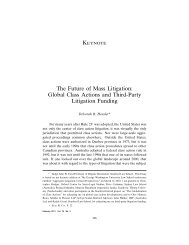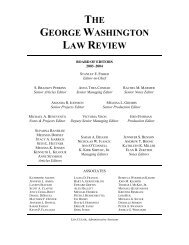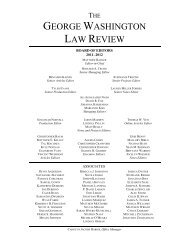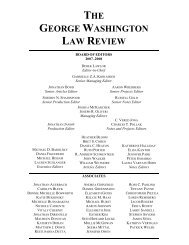View PDF - The George Washington Law Review
View PDF - The George Washington Law Review
View PDF - The George Washington Law Review
Create successful ePaper yourself
Turn your PDF publications into a flip-book with our unique Google optimized e-Paper software.
882 <strong>The</strong> <strong>George</strong> <strong>Washington</strong> <strong>Law</strong> <strong>Review</strong> [Vol. 78:870<br />
character in Penn Central. 72 This definition became less tenable after<br />
the Loretto decision, where the Court held that a regulation resulting<br />
in a permanent physical occupation not only constituted a factor to<br />
consider, but was determinative. 73<br />
A second plausible definition of the character prong is the importance<br />
of the regulation to the public interest. For instance, in Keystone<br />
Bituminous Coal Ass’n v. DeBenedictis, 74 the Court, in holding<br />
that a statute regulating coal mining did not constitute a regulatory<br />
taking, explained that the public interest outweighed private interests.<br />
75 Defining character as relating to the public interest is also an<br />
approach commonly used by the Federal Circuit. 76<br />
A third possible definition of the character prong is whether the<br />
government is acting in bad faith. <strong>The</strong> Court in Tahoe-Sierra Preservation<br />
Council, Inc. v. Tahoe Regional Planning Agency, at the very<br />
least considered such a meaning. 77 In that case, the Court mentioned<br />
bad faith among various possible justifications for relief, but ultimately<br />
held that the district court had already determined that the<br />
agency acted in good faith. 78 Like the public interest definition of<br />
character, the Federal Circuit has also applied the bad faith meaning. 79<br />
Another meaning assigned to the character factor may be that it<br />
relates to whether the regulation fails to substantially advance a legitimate<br />
state interest. As stated above, however, this definition was advanced<br />
as a test independent from Penn Central in Agins 80 and was<br />
72 See supra note 39 and accompanying text.<br />
73 See Loretto v. Teleprompter Manhattan CATV Corp., 458 U.S. 419, 426 (1982).<br />
74 Keystone Bituminous Coal Ass’n v. DeBendictis, 480 U.S. 470 (1987).<br />
75 See id. at 506. <strong>The</strong> commonwealth enacted the regulation “to protect the public interest<br />
in health, the environment, and the fiscal integrity of the area.” Id. at 488.<br />
76 See, e.g., Bass Enter. Prod. Co. v. United States, 381 F.3d 1360, 1370 (Fed. Cir. 2004)<br />
(holding that courts should examine the purpose and importance of the public interest underlying<br />
the enactment of a regulation when deciding regulatory takings claims).<br />
77 Tahoe-Sierra Pres. Council, Inc. v. Tahoe Reg’l Planning Agency, 535 U.S. 302, 333<br />
(2002).<br />
78 See id. <strong>The</strong> Court analyzed whether moratoriums on development, which lasted thirtytwo<br />
months, constituted a regulatory taking. See id. at 306. <strong>The</strong> moratoriums’ purposes were to<br />
allow for research to be conducted on the impact of development on Lake Tahoe so that, ultimately,<br />
a comprehensive land use plan could be devised. See id. <strong>The</strong> Court noted that, if not for<br />
the district court’s holding, it “might have concluded that the agency was stalling in order to<br />
avoid promulgating the environmental threshold carrying capacities and regional plan mandated<br />
by [a previous agreement].” Id. at 333.<br />
79 See, e.g., Cooley v. United States, 324 F.3d 1297, 1307 (Fed. Cir. 2003) (holding that,<br />
“[i]n conducting a Penn Central analysis, the trial court may weigh whether . . . conduct evinces<br />
elements of bad faith”).<br />
80 See Agins v. City of Tiburon, 447 U.S. 255, 260–61 (1980).









